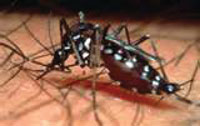
Dengue management: Planned urbanisation is a must
Parvez Babul | Thursday, 3 September 2015

Dengue re-emerged in Bangladesh in 2000 after an earlier outbreak as Dhaka Fever in the 1960s. The latest incident of outbreak created an uproar and raised public-health concern. Bangladesh demonstrated appreciable competence in managing the cases, with continued decline in mortality. Training of healthcare providers on dengue management and increased awareness must have contributed to the achievement. Dengue attacks seriously twice a year-once in May-June and the other, in September-October. In other months of the year, low prevalence exists. Dengue is concentrated in urban settings due to unplanned urbanisation with difficult-to-maintain sanitation, offering abundant breeding places for Aedes mosquito (Ministry of Health, Bangladesh, 2014).
Dengue, the deadly but preventable disease, is now a talk of the town. Many people were infected recently like other years. Ministry of Health of Bangladesh informed that 671 cases of dengue infection were reported in 2012. The number of infected people was: 2011: 1362; 2010: 409; 2009: 474; 2008: 252; 2007: 466. But in 2006, the number of dengue cases was 2198, whereas the number was 1047 in 2005, 3934 in 2004, 486 in 2003, 6132 in 2002 and 2430 in 2001.
Awareness building to prevent dengue infection nationally is a demand of time. Also, immediate research is needed to manage the impact of climate change and environmental degradation in increasing the breeding grounds to the Aedes mosquitoes in our country.
Dengue is a mosquito-borne infection. In recent years it has become a major national and international public health concern. Dengue is a viral infection spread by day-biting Aedes mosquitoes. They breed in water tanks and places where clean water and rain is stored. The illness is unpleasant with high fever and intense muscle and bone pains.
Mosquitoes with black and white stripy legs breed in water tanks and elsewhere wherever rainwater exists in water pots, car tires, broken pots, holes in trees and in the bracts of big plants like pineapples. Aedes bites are slightly painful and very itchy and they can bite through thin clothes. They are often noticeable in gardens.
It is a matter of surprise that mosquitoes can fly more than five kilometers from the pond where they were born, but they are lazy and prefer to bite close to their breeding grounds. According to the World Health Organisation (WHO) , dengue is found in tropical and subtropical regions around the world, predominantly in urban and suburban areas. Dengue haemorrhagic fever is a leading cause of childhood mortality in several Asian countries. The disease is endemic in more than 100 countries located in South-East Asia, Africa, the Americas, the eastern Mediterranean and the Western Pacific.
The spread of dengue is attributed to the expanding geographical distribution of the four-dengue virus serotypes and of their urban mosquito vector-Aedes aegypti. Outbreaks of dengue/ dengue haemorrhagic fever have been reported in Bangladesh, China, India, Maldives, Pakistan, Sri Lanka, and the Caribbean and in eastern, western and central Africa. Priorities for funding include socioeconomic and behavioural studies related to community-based vector control, improving surveillance and epidemic response, health systems and control operations with regard to prompt diagnosis and standardized treatment, development of diagnosis and clinical predictive tests, case management of dengue/ dengue haemorrhagic fever to prevent complications and improve survival.
The geographical distribution of dengue has greatly expanded and the number of cases has increased dramatically in the past 30 years. It is now endemic in more than 100 countries and threatens the health of about 40 per cent of the world's population (2.5 billion people). Over 1.2 million cases were reported to WHO in 1998, the greatest number ever in a single year. An estimated number of 50 million people are infected by dengue annually, including four hundred thousands cases of dengue haemorrhagic fever, a potentially lethal complication, first recognised during the 1950s and today a leading cause of childhood mortality in several Asian countries. The increase of dengue and dengue haemorrhagic fever is due to uncontrolled population growth and urbanisation in the absence of appropriate water management, the global spread of dengue strains via travel and trade and the erosion of vector control programmes.
There are four dengue virus sterotypes and infection with one type provides immunity to only the homologous type. Thus people may suffer multiple dengue infections. Fever and debilitating myalgias typically characterize dengue infection, but infection can also result in haemorrhagic manifestations and shock.
The risk of dengue haemorrhagic fever is approximately 0.2 per cent during the first dengue infection but increases ten-fold during infection with a second serotype of dengue virus. The case-fatality rate of dengue haemorrhagic fever can be as high as 15 per cent if the disease is not treated correctly.
While there is no specific treatment, careful clinical management and intensive supportive therapy can reduce mortality to less than 1.0 per cent. Vaccine development is difficult, because four different viruses cause the disease and the vaccine must provide protection to all four viruses, otherwise recipients may be at increased risk of dengue haemorrhagic fever. Control of the mosquito vector is currently the only option available for reducing dengue and dengue haemorrhagic fever. We must work together to prevent dengue, because prevention is always better than cure.
The writer is a media person and a member of Health Information for All (HIFA), London.
[email protected]